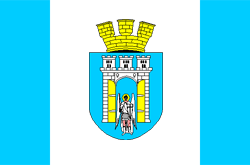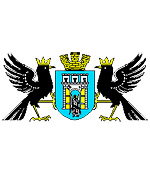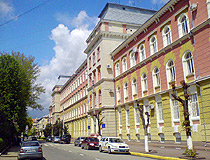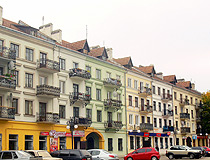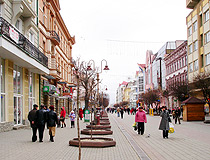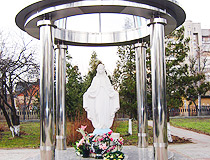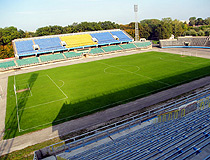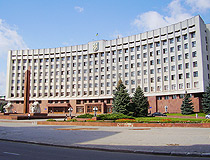History of Ivano-Frankivsk
Foundation of Ivano-Frankivsk (Stanislawow)
Ivano-Frankivsk was founded by Andrzej Potocki, a Polish nobleman, magnate and military commander, in 1662. He named the town Stanislawow - either after his father, Stanislaw Potocki, or his son Stanislaw, or Saint Stanislaus the Martyr, the first Polish-born saint.
In 1663, King John II Casimir of Poland officially approved the coat of arms of Stanislawow and granted it the Magdeburg right (the town could have self-government, elect a headman and a court). It played an important role in protecting the Polish lands from the raids of the Crimean Tatars and Zaporizhzhya Cossacks and became a stronghold of the Polish magnates Potocki in Halychyna (Galicia).
In 1666, the construction of the town hall was completed. In 1672, the fortress was rebuilt in stone; at the same time the Potocki stone palace was built. In September 1676, during the Polish-Ottoman war of 1672-1676, Stanislawow was attacked. Although the Ottomans were unable to take the fortresses, its walls were badly damaged.
More historical facts…
Ivano-Frankivsk in the 18th - early 20th centuries
In the 18th century, it became a significant trade and craft center of Poland. In addition to the Poles, Ukrainians, who made up a significant proportion of the population, Jews and Armenians, whose local communities were quite numerous, made their contribution to the development of its crafts and culture.
In 1772, as a result of the First Partition of the Commonwealth, Stanislawow came under the control of the Habsburg Monarchy (since 1804 - the Austrian Empire, since 1867 - the Austro-Hungarian Empire). The German spelling of the town’s name was Stanislau. The new government no longer needed a fortress in this region. Fortifications were dismantled to construct new buildings and paved roads; new streets were laid on the site of the filled-in fortress ditches.
The second half of the 19th century was marked by the rapid development of industry and the creation of new enterprises. A considerable impetus to this was given by the construction of the railway in 1866. In 1868, a great fire destroyed half of the town. In 1890, more than 22 thousand people lived in Stanislau, the Jewish community of the town numbered about 12 thousand people.
In 1915, during the First World War, Russian troops reached Stanislau and heavy fighting took place in this region, which greatly damaged the town. In 1917, it was occupied by Russian troops. In early 1918, after the conclusion of the Treaty of Brest-Litovsk, the Austrian authorities returned to Stanislau. During the war, a lot of unique buildings were destroyed. Later they were restored, but in other styles and forms.
In 1918, after the collapse of the Austro-Hungarian Empire, the West Ukrainian People’s Republic was created. In January-May 1919, Stanislau was its capital. In May, the town was occupied by Polish troops. From then until the outbreak of World War II, it was the administrative center of the Stanislawow Voivodeship of the Polish Republic.
Ivano-Frankivsk during and after the Second World War
According to the 1931 census, there were 198,359 residents in the city, of which 120,214 (60.6%) were Poles, 49,032 (24.7%) Ukrainians, and 26,996 (13.6%) Jews.
On September 1, 1939, German troops attacked Poland, and World War II began. On September 17, 1939, under the terms of the Molotov-Ribbentrop Pact, the Red Army of the Soviet Union entered the territory of Eastern Poland. Later it became part of the Ukrainian Soviet Socialist Republic. On October 27, 1939, Soviet power was established in Stanislawow. The Russian spelling of the city’s name was Stanislav.
On July 2, 1941, the city was occupied by Hungarian troops, allies of Nazi Germany that attacked the USSR on June 22, 1941. On July 26, 1941, Stanislav came under the control of the German occupation administration. During the occupation, almost the entire Jewish population of the city, about 30 thousand people, was exterminated. On July 7, 1944, the city was again occupied by the Red Army. By this time, only about 100 Jews remained alive in Stanislav.
Until the mid-1950s, this city remained one of the main centers of the armed struggle of underground Ukrainian organizations against the Soviet regime in Western Ukraine. As a result of the post-war population exchange between Poland and the Ukrainian SSR, the Polish population of Stanislav was evicted to Opole, and people of Ukrainian nationality, who lived in the town of Krynica-Zdroj, moved to Stanislav.
In 1959, the population of the city was only 66 thousand people. In 1962, in the year of the 300th anniversary of Stanislav, it was renamed Ivano-Frankivsk in honor of the Ukrainian poet, writer and public figure Ivan Franko, who repeatedly visited it, wrote and read his works here. By 1971, the population almost doubled and reached about 110 thousand people. In 1989, it was about 214 thousand people.
Beautiful architecture of Ivano-Frankivsk
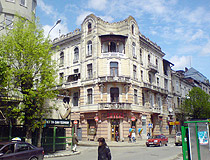
Architecture of Ivano-Frankivsk
Author: Ruslan Pala
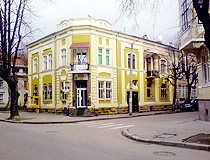
Ivano-Frankivsk architecture
Author: Ruslan Pala
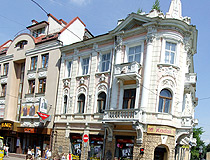
In the central part of Ivano-Frankivsk
Author: Andrey Shyshkin
Ivano-Frankivsk - Features
Ivano-Frankivsk is a small cozy regional center with a European atmosphere and rich history. It is located in the south-west of Ukraine, about 150-300 km from the borders of Poland, Romania, Hungary, Slovakia, which creates favorable conditions for the multilateral development of the city.
The coat of arms of Ivano-Frankivsk depicts a fortress wall with three towers and open gates, symbolizing its foundation as a defensive outpost. It is similar to the coat of arms of Stanislawow adopted in 1663. In the open gates you can see the figure of the Archangel Michael - the patron and protector of the city. Black jackdaws with crowns symbolize the Galician land, on the territory of which the Stanislawow fortress was founded.
In everyday life, the abbreviated name Frankivsk is often used. The City Day of Ivano-Frankivsk is celebrated on the second Saturday of May. The climate is temperate continental with long springs, not too hot summers and mild winters. The average temperature in January is minus 4.2 degrees Celsius, in July - plus 18.6 degrees Celsius.
The main types of local public transport are trolleybuses, buses and mini-buses. The international passenger railway communication is carried out with Bulgaria, Belarus, Romania. The international airport of Ivano-Frankivsk provides regular flights to Kyiv. Ivano-Frankivsk is a relatively large center for machine-building, woodworking, chemical and light industries.
Ivano-Frankivsk began with Rynok (Market) Square and the town hall. In a slightly modified form, they are preserved to this day. Its further development reflected the urban planning ideas of the Baroque era about the “perfect town”, embodied in the planning of its central part, its streets and churches. For the originality of architecture, Ivano-Frankivsk is sometimes called “small Lviv”. Two days is enough to visit the main attractions of the city.
Over the past few years, Ivano-Frankivsk has been talked about as one of the most innovative and modern cities in Ukraine. When reconstructing streets and creating public spaces, the wishes of pedestrians, cyclists and people with disabilities are taken into account. Ivano-Frankivsk has a fairly well-developed infrastructure with a lot of shops, hotels, bars, and cafes.
Fairs, music and cultural festivals are regularly held in Ivano-Frankivsk and its surroundings. From this city in Western Ukraine and from its railway station, a lot of tourists begin their journey to the Ukrainian Carpathians. Ivano-Frankivsk Oblast is one of the most popular tourist regions in Ukraine.
Main Attractions of Ivano-Frankivsk
Town Hall (1928-1935) - the main symbol of Ivano-Frankivsk standing on Rynok (Market) Square, the central square and the historical center of the city. This is one of the few town halls in Ukraine built in the constructivist style with art deco elements. The height of the building is about 50 meters. Its observation deck offers a beautiful view of Ivano-Frankivsk.
Today, it houses the Museum of Local Lore, which presents such expositions as numismatic, archeological, ethnographic, philatelic, paleontological. The ethnographic collection is of particular interest, you can compare clothes, jewelry and household items of Ukrainians from different parts of the Carpathian region.
In front of the town hall building, a bizarre structure in the form of an ostrich egg attracts attention. This rather unique composition, made of concrete, is a fountain. There are a lot of comic legends about this sculpture. Most of the entertainment events in Ivano-Frankivsk take place on Rynok Square: exhibitions, competitions, festive concerts, festivals.
Armenian Church of the Immaculate Conception of the Blessed Virgin. In the immediate vicinity of Rynok Square, between the residential buildings, you can see a majestic church of blue azure color - an architectural monument of national importance. The church was built by the local Armenian community in the Baroque style in the middle of the 18th century. Today, it belongs to the Orthodox Church and is called the Cathedral of the Intercession, but the name Armenian Church has stuck among the locals. Virmens’ka Street, 6.
Ivano-Frankivsk Regional Art Museum (Collegiate Church). This museum, located in the very center of Ivano-Frankivsk, has an excellent collection of works of art: unique monuments of Galician icon painting and baroque sculpture, works by Ukrainian artists, as well as works by Polish, Austrian, German, and Italian masters of the 18th-20th centuries. A significant part of the collection is made up of works of folk art.
The museum is housed in the building of the former church - the Collegiate Church of the Blessed Virgin Mary (1672-1703), a historical and architectural monument of national importance. Sheptyts’koho Square, 8.
Holy Resurrection Cathedral (1720-1763) - a former Jesuit church built in the style of the Austro-Bavarian baroque with elements of classicism. The tops of the towers are made in the style of Hutsul wooden architecture. Today, it is a Greek Catholic church. Sheptyts?koho, Square 22.
“Stometrivka” (literal meaning “one hundred meters”, colloquially “sotka”) - a pedestrian part of the historical Nezalezhnosti Street starting from Vichevyi Square and ending with Ivana Franka Street. Its length, despite the name, is almost half a kilometer. You can find a lot of cafes, bars, restaurants, various shops, and boutiques here.
There are also numerous forged sculptures on this street. All main events of Ivano-Frankivsk take place here, for example, the Festival of Blacksmiths (early May), one of the largest blacksmith festivals in Eastern Europe. On both sides of the street there are interesting buildings constructed in the styles of baroque or classicism.
Ivano-Frankivsk Fortifications (The Bastion). This fragment of a defensive wall with a bastion is practically all that remains of the old Stanislawow fortress in Ivano-Frankivsk. Today, the restored complex houses the Bastion Gallery - a shopping and entertainment complex that includes a terrace for walking and a gallery with souvenir, clothing, perfume shops, as well as a cafe, a restaurant, and a contemporary art gallery. Fortechnyi Lane, 1.
Sichovykh Stril’tsiv Street - one of the few streets in Ivano-Frankivsk where the Austrian buildings of the 1870-1910s have been preserved. About 30 monuments of history and culture are located on this street. Almost every building has its own interesting history. Ivan Franko lived in one of them.
Taras Shevchenko Park - the main park of Ivano-Frankivsk located between Het’mana Mazepy and Viacheslava Chornovola streets. This spacious park with an area of about 24 hectares has the status of a monument of landscape art and a dendrological park (more than 6,000 trees of 62 species). This is a great place for walking. Immediately next to the park you can find the city lake, which was artificially created in 1955. It is also called the Stanislav Sea. Here you can feed ducks, sail on a catamaran or a boat.


